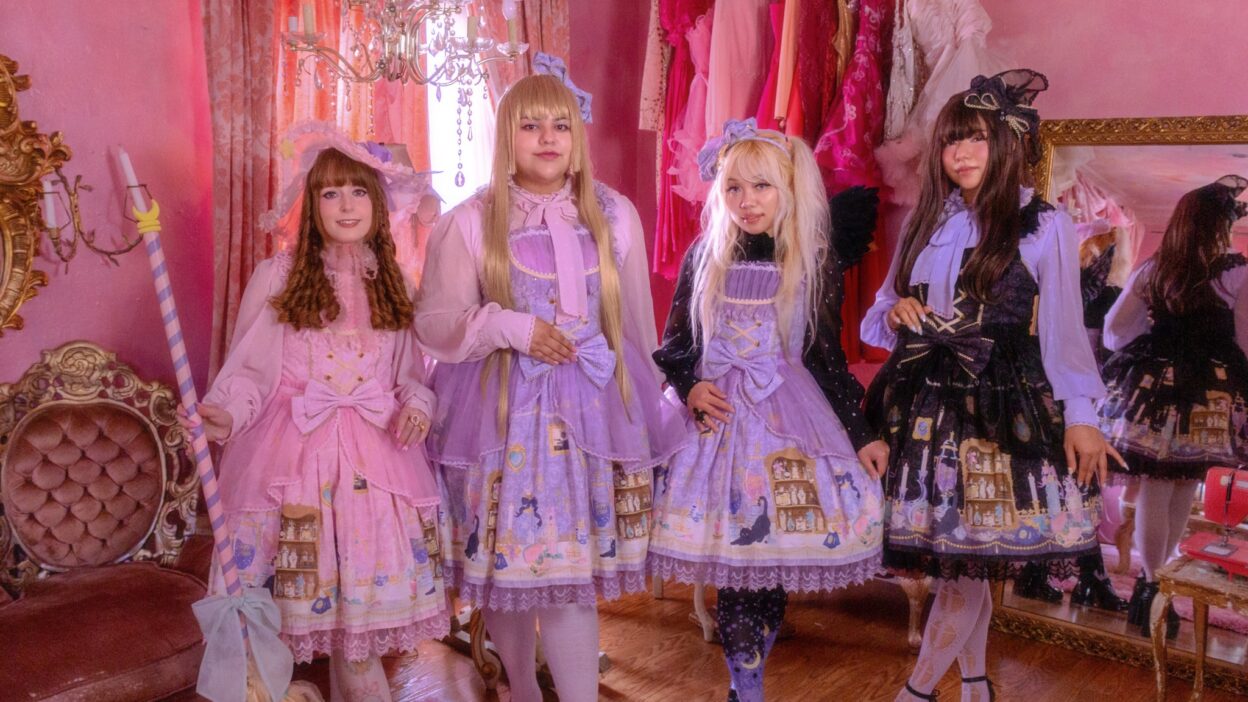Lolita fashion is often a case of “you know it when you see it,” featuring certain staples including a petticoat, a blouse, headwear, and a bell-shaped or A-shaped dress. These components are often decorated with exhaustive detail and accessories based around a theme. While over time, these elements have become neither exhaustive nor essential, they aim to contribute to the key identifier of Lolita fashion: the silhouette, which emphasizes the difference between the waist and the hem of the skirt, with a dress that typically flares out at the hip, creating a bell or cupcake shape.
The birth of Lolita is unclear, but can be traced to 1970s and 1980s Japan. It developed out of the “otome,” or “maiden” movement—a fascination with cuteness, combined with an obsession with Victorian- and Rococo-era clothing, in the streets of Tokyo’s Harajuku shopping district. Soon enough, major Japanese brands like PINK HOUSE and Angelic Pretty opened, selling outfits reminiscent of the characters in literary works such as Anne of Green Gables and Alice’s Adventures in Wonderland. Lolita style, however, is not related to, and has nothing to do with, Vladimir Nabokov’s controversial novel, Lolita.
Instead, Lolita style has its own meaning in the fashion world, representing an inherently multicultural image of a Japanese-born style founded on European aesthetics that has now made its way across the globe. Lolita fashion has surpassed being exclusive to a single culture. In nearly half a century, the style has risen from the streets of Harajuku and spread worldwide. While some still strongly adhere to the original “rules” of Lolita, its change in response to culture has been inevitable.
For some, the dark, brooding nature of gothic Lolita might fit their taste. To others, the cute, pastel colors of sweet Lolita might be more fitting. Others still might even choose the Baroque elegance of classic Lolita, or find a way to merge all three.
“It’s all about expressing this love for femininity and this love for extravagance and attention to detail,” says Millennia Nan, the owner of independent Lolita brand Sleepyland. “(It’s about) celebrating the love for intricate details, craftsmanship, and creativity all in the form of clothing.”
While Sleepyland is primarily based in the United States, Nan currently lives in Taiwan, as she seeks to expand her brand across Asia.
Jenna Shivley wears classic Lolita style in the Last Bookstore in Los Angeles.
Eileen Zayas
A history of cultural change
Like many trends, the expansion of Lolita fashion coincided with the advent of the Internet. Notably, LiveJournal served as a space where members of the community connected, whether through sales posts or written blog posts. In the 2010s, much of this activity moved to Facebook, and during the pandemic, Discord became the next destination.
Meanwhile, as Lolita brands like Metamorphose temps de fille and Baby, the Stars Shine Bright began expanding into the Western market, it made the once hard-to-obtain hobby far more accessible. But shipping the clothes, and the exorbitant related costs, still made importing outfits difficult. So some Lolita enthusiasts took things into their own hands. “I think that’s the reason why a majority of indie brands started,” says Lauma “Zeloco” Vāvere, the owner of Latvian brand Eat Me Ink Me. “I didn’t have the money, (but) I had the skills to make it, so I just did that.”
Models pose in outfits by Eat Me Ink Me.
Courtesy of Lauma Vāvere
Indie brands like Sleepyland and Eat Me Ink Me are reflective of Lolita’s global reach. Vāvere, for example, explains how their customer base began in Europe and Asia, but is now largely based in the United States. “The funny thing was, some years ago, I checked which specific state would be my top state (for sales) and Texas was my top state,” they say with a laugh. “I make gothic clothing, so I would think these poor gothic Lolitas in this giant sunny state are struggling through it.”
And it’s more than just market expansion—it’s cultural evolution.
“What some people look at what used to be Lolita 20 to 30 years ago, they wouldn’t call Lolita today,” says Mindy Pile, a San Francisco-based Lolita who organizes events in the Bay Area.
Some of this change is practical, as Nan has made making size-inclusive fashion a priority for Sleepyland, something that some Japanese brands have yet to catch up on. “I think we all acknowledge (Lolita) came from Japanese culture, but I think now there is a lot more freedom in incorporating your own culture and your own preferences into Lolita fashion and it being accepted by the community as a whole,” she says.
But who are the ones donning the dresses?
Finding the right fit
Gabby Salgado looks over Los Angeles’ Exposition Park Rose Garden. She wears a white and tan dress decorated with images of desserts ranging from biscuits to cakes. She wears a matching beret and a teddy bear bag strapped to her back. She describes her style as “sweet,” both literally as well as an overall aesthetic. That said, the entire outfit stemmed from her brown Oxford-style shoes. “I woke up in the morning and I thought about what are the most comfortable shoes that I can wear because I was going to walk around a lot today,” she says. “As much as I wanted to wear something pastel and bright…I have to be practical about what I’m going to do.”
Gabby Salgado.
Eileen Zayas
Salgado has been wearing Lolita style for 10 years but has been deeply curious about it since high school after scrolling through Tumblr scans of KERA and Gothic & Lolita Bible magazines. One day, she decided to take the leap into wearing the style herself.
“Around 2015, I had an epiphany,” Salgado says. “I had very low self-esteem all my life, but in 2015 I was like, ‘When are you going to be good enough for yourself, huh? When are you going to be pretty enough, according to you, to wear this stuff?’”
Gabby Salgado wears a sweet Lolita style at the Exposition Park Rose Garden.
Eileen Zayas
A few miles across town, The Last Bookstore in Los Angeles draws in tourists and regulars alike. And right at home among the rows of literature, Jenna Shivley dons an earthy green dress riddled with roses, and a teapot-shaped necklace. After discovering Lolita fashion in the 2000s, she became entranced by its contrast with the then-popular Y2K and indie grunge styles. “There was something so interesting about these silhouettes that other people were not wearing at the time,” she says, “and these details that were so beautiful and so unique, I think that it was also really interesting to see construction details that you just don’t see in modern fashion.”
Shivley works as a paralegal, and like Salgado, sometimes has to prioritize function. Even so, she often finds ways to mix Lolita style into her everyday clothing. “The last firm that I worked for was in Beverly Hills, and I think you can imagine how I was expected to dress for that particular job,” she says. “That being said, there are a lot of ways that I can incorporate parts of what I wear into my work wardrobe. Sometimes that was a blazer that came from a Japanese brand, or a sweater or a skirt.”
Jenna Shivley.
Eileen Zayas
Members of the Lolita community, from all backgrounds, come together to share their passion. Salgado works at a nonprofit that helps people with developmental disabilities, while Pile is a software engineer. They connect through online servers and sometimes, at in-person events. San Francisco notably serves as a Californian hotspot because brands Angelic Pretty and Baby, the Stars Shine Bright each now have branches in the city.
“I don’t think I’d have nearly so many friends as an adult if it wasn’t for Lolita,” says Pile. “I like meeting people from different walks of life and something like fashion, where we have this in common, but you can also have people where their life outside of Lolita is very different than mine.”
For some, Lolita fashion resonates on a personal level, allowing the wearer to find their own personal means of expression, especially for members of marginalized communities. “I’ve heard from some Lolitas that to them, it’s like wearing armor—they suddenly feel like they can do anything, nothing is going to hurt them, and they have the confidence to go out into the world,” says Salgado.
Jenna Shivley works as a paralegal but finds ways to incorporate Lolita style into her everyday clothing.
Eileen Zayas
In addition, community members have found a way to connect globally, both virtually and physically. Those who bear the silhouette, the future of Lolita is in their hands. As rigid the roots of Lolita are, the greater freedom there is to find beauty beyond those limits. To many of them, the beginning of that journey is simply looking in a mirror.



